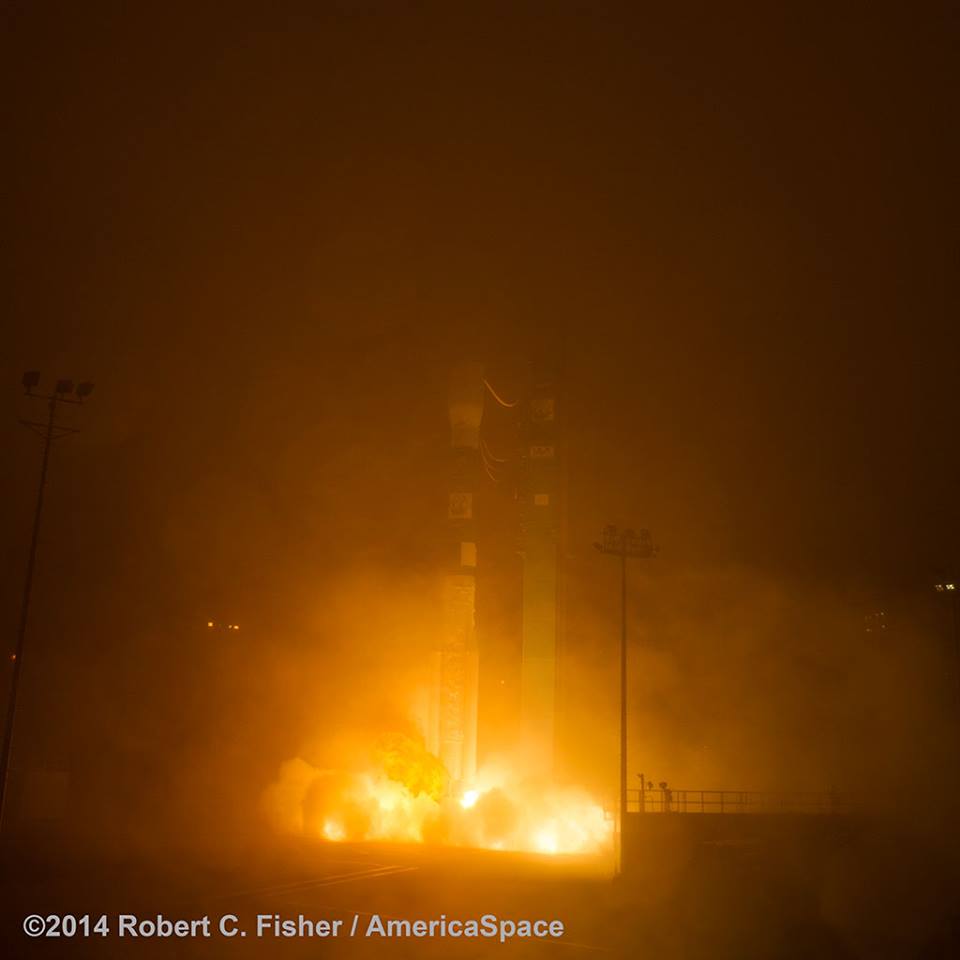
More than five years since its predecessor was lost in the waters of the Pacific Ocean, near Antarctica, NASA’s second Orbiting Carbon Observatory (OCO-2) rocketed into near-polar orbit earlier today (Wednesday, 2 July), in a blazing nocturnal liftoff which turned night into day and marked the rousing return to flight of the Delta II booster. Having been scrubbed yesterday (Tuesday), due to a last-minute glitch with the launch pad’s water suppression system, today’s attempt ran with crispness and perfection. Liftoff occurred right on the opening of a brief, 30-second “window,” at 2:56:23 a.m. PDT (5:56:23 a.m. EDT) from Space Launch Complex (SLC)-2 at Vandenberg Air Force Base, Calif. Over the course of almost an hour, the two-stage Delta II powered the 970-pound (440 kg) OCO-2—which represents NASA’s first spacecraft wholly dedicated to the global study and characterization of atmospheric carbon dioxide levels—into an operational orbit of 370 nautical miles (686 km), inclined 98.2 degrees to the equator.
Conducted under the auspices of United Launch Alliance (ULA), today’s mission represents the seventh cumulative flight in 2014 by a member of the company’s Atlas and Delta family of rockets. By the numbers, four Atlases have roared aloft, transporting NASA’s latest Tracking and Data Relay Satellite (TDRS) into orbit in January, a Defense Meteorological Satellite Program (DMSP) in April, and the National Reconnaissance Office’s NROL-67 and NROL-33 classified payloads in April and May respectively. In addition, three Deltas have speared for the heavens. In addition to today’s return to flight of the Delta II, a pair of Delta IV Medium+ vehicles flew in late February and mid-May to deliver two members of the Global Positioning System (GPS) IIF satellite constellation into orbit. Of these seven missions, all took place from Cape Canaveral Air Force Station, Fla., with the exception of today’s OCO-2 launch and DMSP-19, which flew from Vandenberg.
Originally tracking a launch at 2:56 a.m. PDT (5:56 a.m. EDT) Tuesday, weather conditions for the Delta II and OCO-2 remained favorable, with the minor exception of fog, which was expected to almost totally enshroud the vehicle but was not anticipated to cause a problem for a successful liftoff. Due to the brevity of the 30-second “window” to get the satellite into its near-circular, near-polar orbit, the exact launch time—to the second—had to be determined before the countdown clock was released from its final hold at T-4 minutes. “There is not enough time,” it was stressed by AmericaSpace’s Launch Tracker, “once the clocks are running at T-4 minutes to reset and restart the countdown.”
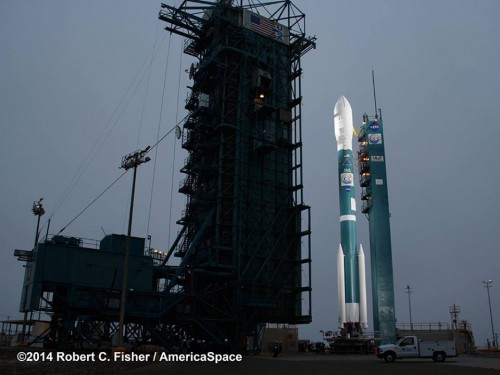
By midnight PDT on Monday, 30 June (3:00 a.m. EDT Tuesday, 1 July), the danger area around SLC-2 had been cleared of all personnel. Shortly thereafter, the Delta II’s guidance system was activated and the loading of RP-1 (a highly refined form of rocket-grade kerosene) and liquid oxygen into the first stage tanks got underway. By 12:46 a.m. PDT (3:46 a.m. EDT) on 1 July, RP-1 loading had been concluded. A few minutes later, U.S. Air Force meteorologists reported that weather conditions were “Green” (“Go”) for launch and, following a poll of all stations by the NASA launch manager and launch director, authorization was granted to begin loading liquid oxygen directly aboard the first stage. Proceeding through its slow-fill and fast-fill phases, the liquid oxygen was loaded by 1:40 a.m. PDT (4:40 a.m. EDT), after which the so-called “Replenishment Mode” got underway to continuously top up the boiled-off cryogenics and keep them at close to flight levels until shortly before liftoff. This produced a ghostly view for spectators and long-range cameras, as the lower half of the rocket seemed enshrouded in an eerie grey-white murkiness.
As the countdown wore on, the Delta II’s hydraulic systems were initiated and the gimbaling mechanism of the RS-27A first stage main engine was tested. By 2:00 a.m. PDT (5:00 a.m. EDT), Range approval had been granted to press ahead with the launch. A final weather briefing at 2:19 a.m. PDT (5:19 a.m. EDT), utilizing the results of the latest meteorological balloon data, confirmed optimum conditions and issued a “Go for Launch.” The Flight Termination System (FTS)—tasked with destroying the Delta II in the event of a major, off-nominal event during ascent—was armed and at 2:52 a.m. PDT (5:52 a.m. EDT), the clock was released at T-4 minutes to begin counting the final 240 seconds towards liftoff. During these final minutes, updated weather data was implemented into the flight plan and uploaded into the rocket’s avionics system and the OCO-2 payload was placed onto internal battery power. No longer dependent upon power support from ground systems, the satellite would run on its own batteries until it achieved orbit and deployed its electricity-generating solar arrays.
The Delta II itself was coming alive, almost three years since its last mission. It was placed onto internal power, its ordnance was armed, as were the pyrotechnics which would fire its three strap-on Solid Rocket Motors (SRMs). External fuel lines were purged, liquid oxygen levels were confirmed at flight pressure, hydraulics were placed onto internal power, and at 2:55 a.m. PDT (5:55 a.m. EDT)—with 60 seconds remaining on the clock—the Launch Director issued a “Go for Launch.” Liquid oxygen fill and drain valves were closed and a “Green” status was received from all stations at T-15 seconds.
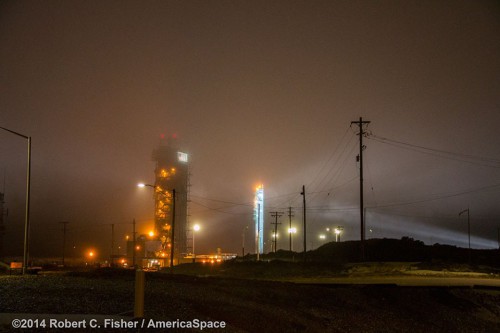
All at once, Tuesday’s countdown stopped at 2:56:33 a.m. PDT (5:56:33 a.m. EDT), with an abrupt “Hold! Hold! Hold!” from a member of the launch team. With such a short launch window, it was apparent that a scrub of at least 24 hours was unavoidable. ULA’s Jessica Rye explained that the scrub had been called “due to an issue with the water suppression system that is used to flow water on the launch pad to dampen the acoustic energy during launch.” She added that, “pending troubleshooting,” a revised launch time had been established, exactly 24 hours later, on Wednesday, 2 July, again at 2:56 a.m. PDT (5:56 a.m. EDT). It later became clear that a valve which formed part of SLC-2’s pulse suppression water system, which had operated normally during tests, had failed in the final minutes of Tuesday’s opening launch attempt. The faulty valve was replaced and tested.
Shortly before 11 p.m. PDT Tuesday (2 a.m. EDT Wednesday), the launch teams were again called to stations to support the second effort to get OCO-2 into orbit. As with the previous attempt, meteorological conditions were near-perfect, save only for the fog. “The weather is not going to be an issue today,” reported AmericaSpace’s Launch Tracker. “The weather officer predicted the same conditions … with a 0 percent chance of any violation of Launch Commit Criteria. As with yesterday, we are expecting the entire complex to be enshrouded by fog. The low visibility will not be an issue preventing launch.”
The final procedures of clearing the launch complex, activating the Delta II’s systems and proceeding through the fueling of the first stage with liquid oxygen and RP-1 continued in a manner not dissimilar to yesterday. The second stage carried nitrogen tetroxide and Aerozine-50—the latter a half-and-half hypergolic mix of hydrazine and unsymmetrical dimethyl hydrazine (UDMH), which, despite its highly toxic and corrosive nature, is capable of remaining in the Delta’s tanks for up to five weeks—and had been loaded several days earlier. At 2:52 a.m. PDT (5:52 a.m. EDT), the clock was picked up at T-4 minutes, with a “Green” status across all stations. For the second time in as many days, the Delta II’s ordnance was armed, its SRM ignition system was armed, its external fuel lines were purged, its liquid oxygen load was confirmed at flight pressures, and its hydraulic systems were placed onto internal power.
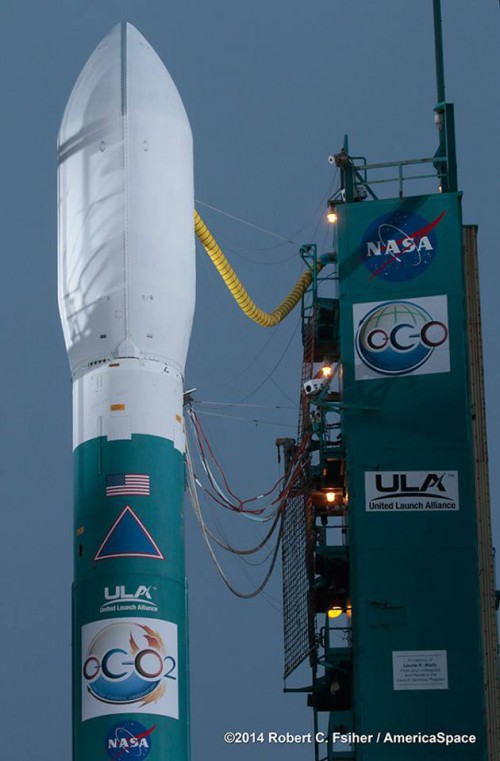
Sixty seconds …
With a single minute left before liftoff, the Launch Enable Switch was set to Flight; at this stage, the automatic sequencer could only be interrupted by a last minute “Hold! Hold! Hold!” call from a member of the launch team or an abort from one of the rocket’s automated systems. The launch pad’s water deluge system was activated at T-45 seconds, flooding the SLC-2 surface and into the flame trench in order to reduce the reflected energy at the instant of liftoff. The liquid oxygen fill and drain valves were closed for flight and at 2:56:21 a.m. PDT (5:56:21 a.m. EDT), at T-2 seconds, the Rocketdyne-built RS-27A main engine roared to life, gradually building up power to its full sea-level thrust of around 200,000 pounds (90,700 kg). Two seconds later came the staccato crackle of the three SRMs and the vehicle was released from the pad.
Each of the SRMs measured 42 feet (12.8 meters) in length and each generated about 110,800 pounds (50,250 kg) of propulsive yield. Together with the RS-27A, and a pair of vernier engines for roll controllability, these powerhouses pushed the Delta II stack away from SLC-2 and established it onto the proper flight azimuth for the insertion of OCO-2 into orbit. Flying in a southerly direction, out over the Pacific Ocean, the vehicle punched through Mach 1 at T+35 seconds and, at T+49.7 seconds, encountered a period of maximum aerodynamic stress on its airframe—a phenomenon known as “Max Q.” Sixty-four seconds into the ascent, the three SRMs exhausted their solid, powder-based fuel and burned out, but remained attached to the rapidly moving Delta II for another half-minute. They were finally jettisoned at T+99 seconds and tumbled back into the Pacific Ocean.
After this point, the RS-27A engine continued to burn hot and hard, shutting down at 3:00:48 a.m. PDT (6:00:48 a.m. EDT), at T+264.2 seconds. Its role in the mission now complete, the first stage was jettisoned shortly afterward, making way for the ignition of the Aerojet-built AJ-10-118K second stage engine at T+277.7 seconds. Unlike the RS-27A, the Aerojet engine was capable of being restarted in flight and supported two discrete “burns” to deliver OCO-2 into orbit. Capable of producing 9,850 pounds (4,470 kg) of propulsive yield, the AJ-10-118K is fed by a hypergolic mix of nitrogen tetroxide and Aerozine-50. Less than half a minute into the first burn, at 3:01:24 a.m. PDT (6:01:24 a.m. EDT), or T+301 seconds, the Payload Fairing (PLF)—responsible for protecting OCO-2 from aerodynamic, thermal and acoustic stresses in the lower atmosphere—was jettisoned, exposing the satellite to the space environment for the first time.
The second stage engine shut down for its First Cutoff (known as “SECO-1”) at 3:06:44 a.m. PDT (6:06:44 a.m. EDT), a little over ten minutes after liftoff. “The rocket is now in a temporary parking orbit,” explained AmericaSpace’s Launch Tracker, “where it will coast for just over 40 minutes, prior to starting for a final time.” It restarted at 3:47:14 a.m. PDT (6:47:14 a.m. EDT), burning for just 12.4 seconds, by which time the second stage and the payload was flying just south of Madagascar. Following the second shutdown (SECO-2), the stage coasted for five minutes, and OCO-2 separated at 3:52:38 a.m. PDT (6:52:38 a.m. EDT). Fifty-six minutes had elapsed since the Delta II left Vandenberg and, unlike its ill-fated predecessor, the OCO-2 satellite was now safely in orbit.
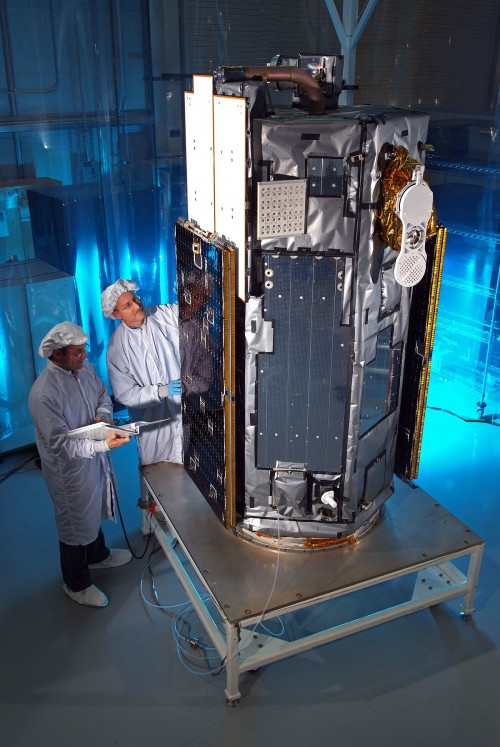
Successful insertion into its correct operational “slot” will come a little more than five years after the ignominious failure of its predecessor, OCO-1. Launched atop an Orbital Sciences Corp. Taurus-XL booster from Vandenberg in February 2009, the mission suffered a failure in its payload fairing, which apparently did not detach properly. The result was that the excess mass of the fairing impaired the thrust of the Taurus-XL’s third stage and the entire vehicle plunged to a watery Pacific grave, just off the coast of Antarctica, a mere 17 minutes after liftoff. The importance of the mission was such that a replacement satellite was funded and in June 2010 NASA announced that another Taurus-XL would deliver OCO-2 from Vandenberg in February 2013. However, in the spring of 2012, Orbital Sciences and NASA jointly decided not to pursue the launch on a Taurus-XL, which imposed further delay upon the already-snakebitten program. Several months later, in July 2012, NASA contracted with ULA to launch OCO-2.
At length, in April 2014, the 970-pound (440-kg) satellite arrived at Vandenberg for final checks ahead of its long-awaited mission. Built by Orbital Sciences, it carries a single scientific instrument to undertake the most precise measurements of atmospheric carbon dioxide levels ever acquired from space. Three parallel, high-resolution spectrometers will perform simultaneous observations of the carbon dioxide and molecular oxygen absorption of sunlight reflected from Earth’s surface at near-infrared wavelengths. This will provide OCO-2 investigators with the “spectral fingerprints” of these absorption profiles as part of efforts to determine the number of molecules between the upper atmosphere and the surface. The instrument has been developed by Hamilton Sundstrand Sensor Systems of Pomona, Calif., together with NASA’s Jet Propulsion Laboratory (JPL) in Pasadena, Calif.
The measurements performed by OCO-2 are expected to be of sufficient accuracy to show the distribution of carbon dioxide “sources” and “sinks” on a regional scale and, by extension, should offer greater insights into our understanding of the global carbon cycle and our own influence upon it. Planned for a baseline mission of two years in near-polar orbit, OCO-2 will fly in conjunction with five other U.S.- and French-provided satellites of the Earth Observing System Afternoon Constellation (or “A-Train”).
As described in Sunday’s AmericaSpace mission preview, the OCO-2 mission was the 152nd flight of a Delta II since its maiden voyage in February 1989, as well as the rocket’s 51st NASA payload. With a record which includes just one outright launch failure and one partial failure, the Delta II boasts a 99.3-percent success rate, making it one of the world’s most reliable boosters currently in operational service. Today’s mission did not disappoint that record. In traditional style, the vehicle received a four-digit Delta designation of “7320.” This describes its membership of the 7000-series of the rocket (“7”), its three-strong complement of strap-on solid-fueled motors (“3”), the presence of a second stage (“2”), and the absence (“0”) of a third stage.
Want to keep up-to-date with all things space? Be sure to “Like” AmericaSpace on Facebook and follow us on Twitter: @AmericaSpace



